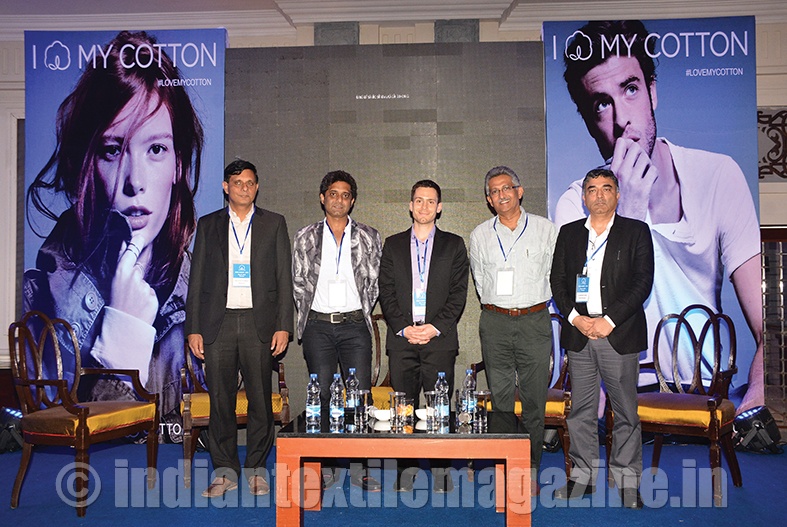A cotton-focused country with emerging retail trends makes the Indian apparel scenario interesting. In the emerging scenario, the launch of Cotton USA, the 25-year-old flagship brand from the Cotton Council International (CCI) in India, assumes significance. As part of the promotional blitzkrieg, the CCI team is touring various metros in the country to launch the brand through an event titled Cotton USA India Summit 2015.
Though cotton consumption has been relatively flat over the last 25 years with man-made fibre overtaking it, when seen in the Indian context, the country still remains cotton-focused. In 2014, cotton has accounted for nearly 54 per cent of the total fibre consumption. “The Indian textile and apparel market is now more than $100 billion and growing at a healthy rate, and it has potential to double its export share from the present 5 to 10 per cent in the next 10 years. We see a huge potential in this market and hence bring the best quality cotton to the Indian consumers,” said David B. Collins, Cotton Council International Senior Advisor.
Though India grows its own cotton, CCI has chalked out a roadmap to establish a consumer connect and make it their choice of fibre. Cotton USA is riding high on it, being a premium cotton brand. It plans to piggyback on its premium quality and build a business in India by developing a complete supply chain to address the demand-supply needs. The brand intends to create a market and work with other brands to create Cotton USA labelled merchandise. The brand plans to promote itself by participating in trade fairs and road shows. This is better understood by the fact that Cotton USA intends to develop a sourcing chain for mills and manufacturers in the coming months and eventually connect to the demand pie by building a supply chain in the next few quarters.

“We intend to work at three levels comprising manufacturers, brands and retailers. About 93 per cent of the fibre used should be cotton, and this we hope should be Cotton USA,” said Harminder Sahni, Managing Director, Wazir Management Consultants, with expertise in various sectors, including Retail and Fashion (Textile and Apparel).
Cotton as a fibre is perceived as cool, comfortable and durable. About 88 per cent of India feels cotton is an important fibre and suits the Indian weather.
As a brand, Cotton USA’s differential benefits come through factors like purity, sustainability and all-year-round availability. “Premimisation is a well established term in India and is happening across categories. The textile industry is also catching up by using premium quality raw material, fabrics and innovation to make quality products in the country,” added Renu Aggarwal, India Representative for Cotton Council International.
Cotton USA indeed spins a successful story in India, as we move on to retail trends in apparel and footwear.
Retail mantra: Build a Singular Brand Experience
Did you know that one in four consumers shop for apparels and footwear? Or that Indian online apparel and footwear sales is expected to touch Rs 536 billion by 2019? These, coupled with other insights, were take-aways at the Cotton USA India Summit 2015 held in Bangalore in May. “The economic growth of India is projected to be Rs. 238 trillion by 2024. The online population is expected to be over 400 million by 2024.”
“Apparel spending is slated to be Rs. 8.6 trillion by 2024, and India will have a young population where 43 per cent will be less than 25 years of age in 2024,” said Justin Coates, Manager, market analysis corporate strategy and program metrics, Cotton Incorporated.
Desi appeal: International retailers perceive India as a potential market and have raked in considerable profits here. India’s USP is its young population unlike other markets. With this, retail moves to the next level. Broadly speaking, this has resulted in two emerging trends. “International retailers are working with local designers for desi inputs. They are localizing their portfolio. When Marks & Spencer changed the styling to suit the Indian figure and added that necessary dosage of Indian colour to their apparel offerings, their customer base witnessed a dramatic turnaround,” said Coates.

As for the second trend, international retailers are addressing the aspirational needs of consumers in small towns and cities after successfully lapping up consumers in the metros.
Digital dream: Even as international retailers explore newer markets in India, the retail scenario is influenced by fashion forecasts and the economic landscape. The digital world is a relatively new but strong determining factor here. “When it comes to online shopping, in the US people browse through the brand’s website, but in India people click on search engines to throw up various options. They compare prices and rely on social media,” highlighted Coates.
As social media allows for two-way communication, it’s understandable that retailers hook consumers online when they are on social networking sites. In India 3% consumers shop for apparel online, while 5% browse online for ideas.
Though the Indian consumers’ approach to shopping may differ from their western counterparts, what’s hooked them is shopping at the click of a mouse.
Experiential shopping: A time has come when retailers face the challenge of bringing people to the physical store. Even traditionalists are coming around to the new view that value-adds like an in-store experience are the much-required tactics. This can be described as experiential shopping where doses of fun, excitement and adventure help to ensure customer engagement. The cool quotient is high here. In some cases, retailers make shopping a customized experience.
While shopping is a lifestyle choice, shopping habits differ from city to city. “In Delhi 63% of shoppers buy clothes at independent stores that offer a personalized experience,” observed Coates.
In Mumbai, 65 per cent of people buy and wear the latest fashion trends. While in Bangalore, 76 per cent consumers shop for clothes on an impulse, in Kolkata, 10 per cent of buyers shop for apparel online.
So at the end of the day, it’s left for retailers to tailor their offering and build a singular brand experience.
Cotton Connect
Cotton USA is renewable, recyclable and biodegradable, since the fibre comes from the soil. It is contamination-free.
Cotton USA has its presence in more than 50 countries globally. Since 1989, over 50,000 product lines and three billion products have carried the name Cotton USA.
